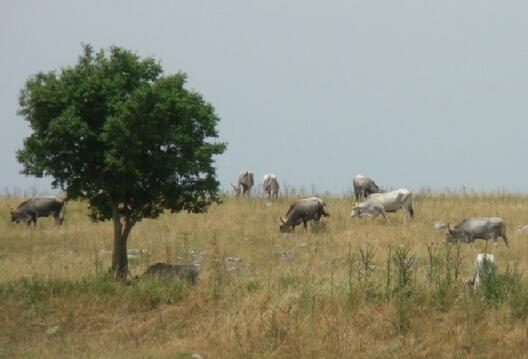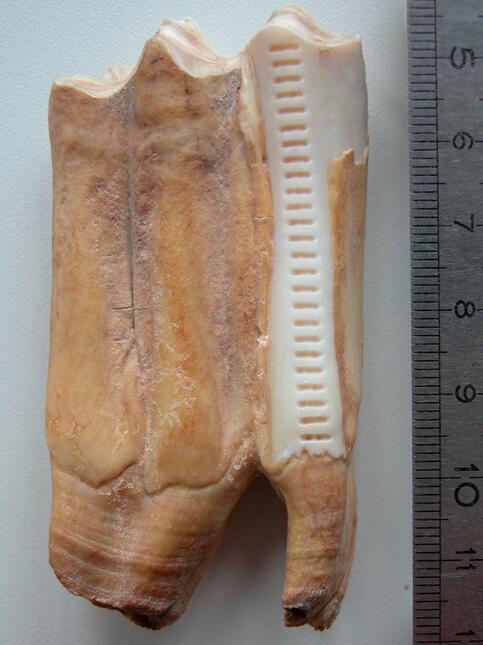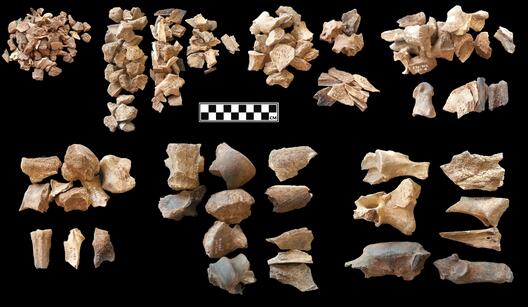The Milking Revolution in Temperate Neolithic Europe
From:Shanghai Archaeology Forum NetWriter:Date:2017-12-14
The introduction and spread of ruminant animal-based agriculture by early Neolithic farmers had fundamental implications for modelling of the Mesolithic-Neolithic transition in Europe. This revolutionary shift in human subsistence strategy completely reshaped prehistoric European culture, biology and economy, in ways that underlie modern life virtually worldwide. Critically, these changes underpin the widespread dissemination of dairy economies globally, and the evolution of Lactase Persistence (LP) in Europeans. The multi-billion Euro modern dairy economy is a direct consequence of human-induced biological reformulations made in this critical phase of European prehistory. Hence, our research focusses on one of the most profound dimensions of the lives of these early farming communities, namely the emergent role of domesticated animals in their evolving subsistence economies and settlement cultures, particularly the factors that underlie cattle becoming the domesticate of choice amongst temperate European Neolithic farmers.Animal husbandry is the cornerstone of subsistence practices and state-of-the-art archaeozoological and chemical and isotopic analyses of faunal remains recovered at archaeological sites can provide hitherto unattainable insights into the prehistoric husbandry, foddering and land-use practices. The environment likely played a fundamental role in influencing the choice of domesticated animal. In the early Neolithic sheep and goat are more predominant in southern latitudes due to their physiological capacity to withstand semi-arid and scrub environments, whereas cattle prevailed in the Northern and central Europe. Cattle were an important component of Central and Northern culture and likely contributed to the rapid expansion of early Neolithic cultures, such as the Linearbandkeramik (LBK) across this region in the sixth millennium BC.

We have used mortality data and profiles based on observations of dental eruption, wear and replacement stages from archaeozoological remains to characterise animal slaughter management, which in turn have been used to study husbandry practices. Dairy husbandry is characterised by the slaughtered of male infants and mature females. Mortality profiles cannot be sexed but by statistically examining the frequency of infant and mature adult classes we can infer milk exploitation. We have shown that ruminants were managed for milk by communities associated with early Neolithic ceramic cultures of Cardial/Impressa (ICW) and LBK. North-Western Mediterranean ICW communities managed caprines for milk, whereas cattle were the primary dairy animals in the Central and Northern early Neolithic LBK communities. Compared to caprines, cattle are slow to mature and so maintenance of animals to maturity requires continuous organisation of fodder resources for successful over-wintering.
Maintaining pasture and adequate winter fodder stocks for cattle would have been a year-round activity, which would have had significant impact on settlement hinterlands. The landscapes of temperate latitudes were naturally forested with early Neolithic communities exploiting natural openings or those formed anthropogenically through clearances. Leafy hay from the forests would have been intensively collected, and used by herders throughout the winter months to maintain their stock. Identification of leafy hay consumption in prehistory is especially difficult since leafy remains are rarely found in the archaeological record. New stable isotopic methods for recovering dietary signals from ruminant tooth enamel, dentine and bone collagen were used to determine the modalities of prehistoric husbandry, foddering and land-use practices. The density of forest canopy can have an impact on the ratios of 13C/12C, which can be recorded in the body tissues, such as dentine, enamel and bone collagen of ruminants pastured within or provisioned with leafy hay. A new compound-specific stable isotope approach based on nitrogen isotopes in dentine amino acids developed during the project has been used to identify forest resource foddering. The success of this approach rests on the differential fractionations of amino acids involved in lignin biosynthesis, which varies systematically in high and low lignin plants. Incremental sampling and stable isotope analysis of cattle molars provides a multi-proxy stable isotope framework for assessing seasonal variations in animal diets relating to the degree of forestation and leafy foddering, and estimates of the length of the birth season.
As a result we now have the earliest evidence for the deliberate use of leafy hay during winter. Significantly, the estimated length of birth season was found to be 4-5 months, indicating a high degree of control over herd breeding to ensure that milk was available well into the winter period. The interrogation of mortality data and stable isotopes suggests that LBK communities invested considerably in cattle herds and husbandry and provisioning of a continuous supply of winter fodder would have influenced social organisation, potentially providing the stimulus for the emergence of the symbolism relating to cattle in Neolithic central Europe.
While meat and milk are obvious products of animal husbandry their fats would have been a vital component of the human diet and our ancestors would have developed strategies to secure a regular supply. The most direct evidence for modes of carcass fat exploitation comes from studies of animal bone. Our work on the LBK culture represents the most comprehensive study into bone fat processing practices ever undertaken. We analysed how intensively past peoples were utilising fat resources derived from animal bone, identifying evidence of bone marrow and grease exploitation through different patterns of bone fracture and fragmentation. Bone fractures with different characteristics dependent upon the level of moisture loss and collagen diagenesis over time, allowing us to separate human-induced fractures, to access marrow, from post-deposition taphonomic fractures caused by trampling, re-deposition, and context disturbance, including excavation damage. Based on these findings we argue that bone fracture can therefore be used to characterise carcass processing, refuse deposition practices and archaeological site formation.

Critically, bone fat exploitation provides an important indicator of dietary demand. Different intensities of bone marrow and grease processing may be undertaken in response to different levels of dietary stress, and leave different archaeological signatures. Bone marrow processing requires the splitting of fresh long bones to access the marrow cavity, whereas grease extraction requires intensive comminution and boiling of cancellous bone render out grease. Thus, the mode of fat exploitation and its intensity may correlate well to dietary stress or a particular lack of other fat sources. Our aim in undertaking this analysis for the NeoMilk project was to assess the contribution of animal bone fats to diet, particularly in light of possible dairying activity, which would provide an alternate source of fat. Dairying provides a rich source of storable fat, so as use of dairy products increased, the need for extensive bone fat exploitation might decrease. This is the specific hypothesis we set out to test.
Our findings suggest that bone grease processing was not practiced intensively on any site. This process, usually associated with hunter-gatherer groups with limited access to large amounts of carbohydrates or rich sources of fat, was likely not nutritionally necessary for LBK farmers with access to domesticated crops and animals. Any evidence for fragmentation of cancellous bone was usually non-intensive and isolated, with limited instances of such fragmentation more likely related to enriching stews. Bone marrow processing on the other hand was present at all sites, but proportions of marrow bones fractured whilst still fresh (peri-mortem), suggestive of marrow extraction, varied between sites. Our research shows a negative correlation between the proportion of bones fractured while fresh and the proportion of milk-producing ruminant animals (cattle, sheep and goats) present. This evidence could crucially imply that sites that had a higher capacity to produce dairy products, relied less on bone fat as a resource.
The proportions of fracture for marrow and post-depositional fracture also varied within sites, between different context types. Varying fracture proportions in these contexts suggest different carcass processing practices and taphonomic histories within a site itself. We have been able to identify contexts that may represent feasting events, with marrow bones roasted, before rapid deposition and burial. Other archaeological features displayed post-depositional fracture and fragmentation related to prolonged use, re-deposition of material accumulated elsewhere, and re-cutting of old contexts. These intra-site differences show spatial variation in archaeological activities that contribute to our understanding of the site as a whole, and extend beyond purely zooarchaeological questions. These investigations highlight the importance and wide applicability of this type of zooarchaeological analysis. Our methodology allows the representation of a sequence of human-induced fracture and fragmentation followed by later taphonomic disturbances, which can be used to reflect site formation processes that have affected all artefacts from archaeological sites. This is particularly useful for artefacts that do not fracture with the same time-sensitive diagnostic features as animal bone. This type of zooarchaeological analysis can and has been applied to sites of many different periods, informing archaeological discussions of diet and subsistence stress, taphonomy and site formation processes.
In summary, our central hypothesis that the rise of dairying reduced the need for other less efficient forms animal fat exploitation appears to be valid and we are now relating these results to the lipid residue evidence for dairy production at the same sites.
The advent of analytical chemical methods, which allow amorphous and invisible organic materials from archaeological contexts to be detected and identified is contributing significantly to answering hitherto intractable archaeological questions, across both temporal and spatial scales. Such analyses target absorbed lipid residues preserved widely in unglazed ceramic vessels. These lipids originate from products stored and/or processed in vessels. They derive either from a single use or an accumulation of cooking events over a vessel’s life history. Lipid residue analysis is applicable to both freshly excavated sherds and those from museum collections. The high sensitivities of instrumental methods, such as gas chromatography and mass spectrometry allow trace amounts of compounds to be detected and identified. Ultra-trace sensitivities can be achieved using selected ion monitoring methods e. g. for the detection of specific lipid biomarkers of aquatic resource exploitation. The advent of gas chromatography-combustion isotope ratio mass spectrometry in the 1990s introduced the possibility of accessing stable isotope information from individual biomarker structures, opening a range of new avenues for the application of organic residue analysis in archaeology. A wide range of commodities can be detected in prehistoric ceramic vessels using organic residue analyses e.g. terrestrial animal fats, such as carcass and dairy fats, aquatic fats, plant oils and waxes, tree resins and beeswax. A major innovation achieved during this project has been the high precision radiocarbon (14C) dating of individual lipids, particularly animal derived fatty acids that occur commonly pottery.
Such approaches have been applied to the largest scale investigation of organic residues in pottery sherds ever undertaken. Approaching 5,000 individual potsherds excavated from LBK settlements across the entire distribution of this keystone prehistoric culture, which ranges from nearly the Atlantic in the west, via the Baltic in the north, to the Black Sea in the east. In the south, it reaches the rivers Sava and the lower Danube at the 44th degree of northern latitude. Hence, pottery from LBK sites situated in all ecological zones and environmental variants (e.g. lowland and upland sites in Poland) are represented. Recent research has put the start of the LBK in early 6th millennium BC. This early formation stage is only found in historical north-western Transdanubia, covering parts of the modern countries of Hungary, Austria and Slovakia. From here on, an early stage of the LBK expanded to the west, reaching the Rhine river at around 5500 BC, and to the north and northeast, reaching the upper Vistula river in its tributaries at about the same time. The next stage, the so-called “middle” LBK, sees a further expansion to finally cover the whole distribution range shortly after 5300 BC. This is followed by what is termed to be “late” and “latest” LBK, from c. 5150 BC, constituting more regionalised groupings. By 4900 BC even the latest LBK pottery types (sensu stricto) have disappeared from the record. These stages of development are well reflected in pottery decorations, and stylistic development, give us a good indication of chronological position.

Pottery samples targeted during the NeoMilk project comprise all chronological phases of the LBK in the respective regions to investigate chronological trends in animal exploitation. The LBK settlement pottery repertoire comprises surprisingly few forms. Beside some hemispherical cups, bottles and amphora, 80% of all vessels are interpreted as ‘cooking pots’, often decorated. Sherds of all available pottery categories were sampled. By far the majority of all LBK pottery sherds derive from the settlement sites, excavated in their thousands in Europe, and here in particular from the lateral oblong pits accompanying the typical LBK longhouses. Seen as originally dug out to provide clay for the house wall constructions, these had been used as refuse pits during the lifetime of the houses, thereby giving us the opportunity to investigate variation on a house-by-house basis as well as comparing settlements and regions.
The results obtained from ca. 5,000 pottery sherds from more 50 archaeological sites submitted to lipid residue analyses are allowing chronological and geographical trends in animal exploitation in these early farming communities in Central Europe, at the site, regional and continental levels. The findings show highly variable intensities in dairy and non-dairy activities across the whole LBK distribution. It is clear that some early farming communities relied on milk and milk products, others mainly sourced their dietary fats from carcass products, bone marrow or grease. The transformation of some of the milk into cheese is evidenced by the detection of milk residues in specialised containers, perforated with millimetre-sized holes and resembling modern and ethnographic cheese-strainers. The manufacture of cheese would have eased handling of milk products and allowed the nutritional properties of milk to be retained throughout the year.
In summary, the NeoMilk project has integrated state-of-the-art methodologies to provide new qualitative and quantitative evidence for the ways in which the LBK communities managed their animals, and processed and consumed their products, and how this varied temporally and spatially across Europe. The molecular and stable isotope analysis of organic residues in pottery provides access to a pivotal proxy for dairy product processing and consumption. A major strength of the project is the repeated integration of faunal evidence with organic residue evidence to provide a critical link between the animal products processed in vessels and ways in which the animals were managed and butchered. These new finding are being brought together and modelled with new dating, palaeoenvironmental and archaeological information to identify the principal influences on changing patterns of animal management and exploitation throughout entire spatio-temporal range of the LBK. The data synthesis in NeoMilk is testing geographical and ecological models relevant to prehistoric environments to define the controls on dairy husbandry during the LBK. The critical last step involves mapping the emergence of intensive dairying on the distribution of the LP allele in prehistoric populations emerging from on-going aDNA studies.

